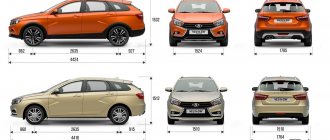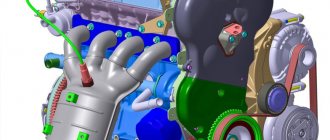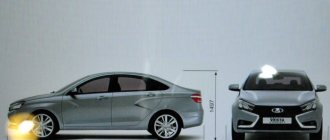Body dimensions are an important parameter when selecting a car. It must be taken into account depending on the purpose for which the vehicle is intended to be used and in what driving conditions. A large car is safer for country trips, but more difficult to drive in the city and less maneuverable. Of course, wheel size is also important. After all, the vehicle’s cross-country ability, its stability, as well as the maximum load it can withstand without the risk of sinking to the asphalt depend on it. The dimensions of the Lada Vesta make this sedan or station wagon an optimal option for city driving, as well as comfortable for country trips on well-paved roads.
Exterior view of Lada Vesta SV Cross
Already in 2022, an unusual domestically produced car appeared on Russian roads. Initially, AvtoVAZ pleasantly surprised the public by releasing the Lada Largus, and now it has offered to purchase the first crossover in its line.
Looking at this car, one immediately notices the increased ground clearance - 203 mm. This will not be enough to conquer wild off-road conditions, but it will be suitable for calmly moving off the asphalt road into rough terrain. And the black plastic body kits are another pleasant visual addition to the increased ground clearance.
Photo source: https://s1.1zoom.me/b5262/882/Lada_Vesta_Cross_Orange_Estate_car_533845_2048x1152.jpg
It is worth noting the powerful enlarged cross-shaped grille, on which a large company nameplate is located; all this is stylishly complemented by chrome inserts. The Lada Vesta SV Cross car and its increased overall dimensions rightfully draw attention to itself from cars of a similar class, such as, for example, the Kia Rio X-Line.
Applicable tire and wheel size
What size wheel rims are needed for the Lada Vesta? Let's once again clarify the dimensions of the Lada Vesta wheels. In the factory version, the Lada Vesta is equipped with alloy wheels R16 and R17 from the manufacturer K&K. The discs are made by injection molding. The Luxury Lada Vesta comes with 2 wheel options:
- K&K Anna 15_6Х15_4Х100_DIA_60_ET_50;
- K&K Ptalomey 16 6X16_4X100_DIA_60_ET_50.
By paying additionally, you can install the same alloy wheels K&K Ptalomey 17 6X17 4X100 DIA 60 ET 50, which are larger in size, which has a positive effect on the stability of the car. If you want to replace alloy wheels with a different design, the recommended parameters are:
- Wheels R16, 175/70, 205/60;
- Wheels R17 175/55, 195/50.
The wheel size for the Vesta concept version should correspond to R18 235 /45.
Salon
The SW did not receive any major differences from the sedan in terms of interior decoration, but still acquired several pleasant features:
- the space above the heads of rear passengers has increased by 2.5 cm;
- an armrest with cup holders was added to the rear seat;
- A separate button is now used to heat the windshield.
Less significant additions to the interior of the new Vesta are an updated soundtrack for the turn signals and additional color inserts on the door handles and dashboard.
Lada Vesta SW Cross: driving test
It’s time to call it a day: all this already bears little resemblance to healthy journalism and even less to work within the framework of the Labor Code. I dream about Vesta. Quite specific - the SW station wagon in the Cross version and in the maximum configuration. Exactly the same one that back in May I first saw in the AvtoVAZ design studio, and then drove from Tolyatti to Izhevsk, but not in camouflage, but with a thermonuclear orange color. Four months of silence under the terms of the embargo - and these night meetings. However, I know how to stop everything, but this is what worries me much more than my dreams.
In the three years since the appearance of the first concept car, I have talked so much about Vesta that, according to the laws of the Zhiguli Mountains, I am now obliged to answer for my words and get married. Although “obliged” is not quite the right word. I'm afraid I really want to buy a Vesta.
As an adult, I perfectly understand the sensitivity of such a situation, but you know what Stockholm syndrome is, right? Three remarks to understand the scale of the disaster: I update the lada.ru website at least three times a day, I know the location and contacts of the four closest Lada dealers, and I subscribe to those two messages a month that AvtoVAZ calls the customer newsletter. Almost every evening I torment the loan calculator, and in the morning I am glad that I have not yet collected a deposit, because I still do not have an answer as to whether it is worth buying Vesta.
It is beautiful, but not cheap, handles well, but accelerates poorly, practical, but voracious. In a word, I'm confused. And when your head is a mess, the simplest shrink tricks come to the rescue. Last week I took a piece of paper and cut it in half so that on the left I could write down everything that makes me think buying a Vesta is a good idea, and on the right the opposite.
And this is what the most frightening part of this summary looks like.
Design manifesto. Maybe beauty won’t save the whole world, but at least it will provide AvtoVAZ with a very, very serious service. The Vesta station wagon is not just the most beautiful VAZ, it is a car that can return the Lada to a society where buying a car satisfies a desire, not a need. I would even say that Vesta SW is somewhat similar to Mini, because I can already imagine a person who would choose it solely because of its appearance. But, of course, you need to choose the Cross version, because Vesta’s large wheels and wide plastic lining are, consider her heels and bikini. No, the usual Vesta station wagon is also very good, but compared to the cross-country one... It’s like if you married a supermodel, but only saw her in the kitchen when she’s looking for aspirin on Saturday morning.
Dear drive. Another reason to choose the SW Cross is the new suspension settings. If the chassis of the base station wagon differs from the sedan’s only in the rear springs increased by 9 mm, then the “cross” Vesta has its own complete set, in search of which the VAZ team went through 40 options for shock absorber settings paired with extended springs. It’s surprising that in the end, Vesta with cross-suspension unexpectedly became even more “asphalt”. At the VAZ testing ground in Sosnovka, I constantly jumped from a regular station wagon to a cross-country car, and the difference between them was like between mineral water and champagne. That is, Vesta is still appropriate in 99% of situations and will satisfy most driver needs, but Cross will also add a sense of celebration to this. The new suspension is denser, reactions are faster and more accurate, with it Vesta rolls less and sways less. This Lada drives smoothly and is expensive - and I didn’t see this as a serious compromise with smoothness and energy consumption. Yes, it emphasizes waves and irregularities more strongly, but I rode the Cross Station wagon 700 km from Togliatti to Izhevsk, bypassing federal highways - and it was a pleasant trip.
The driving program for the station wagons almost completely boiled down to finding suspension settings for the Cross version, since the simple Vesta SW differs little from the sedan. “Cross” shock absorbers with an extended rod are from the Skopin company SAAZ-Komplekt, and standard tires are Pirelli Cinturato P7. Excellent duet! Wheels of size 205/50 R17 are standard on all Crosses, but a 15-inch spare wheel serves as a spare wheel. It’s also worth remembering that beautiful wheels don’t often help you drive fast, so the Vesta SW Cross 1.6 with a “mechanics” according to the passport spends 12.6 s to accelerate to “hundreds”, and the SW Cross 1.8 with a “robot” takes an endless 13.3 s !
Clearance. The extra 25 mm of ground clearance gives the universal Vesta Cross 203 mm under the bottom - Creta never dreamed of this, and Kaptur is only one millimeter higher, but from experience there is more confidence in the Lada's passport clearance. It’s not that I’m going to go off-road, but in light of the fact that we now have snow even in June, and well-maintained Moscow streets go under water after every rainstorm... In a word, we shouldn’t miss the chance to distance ourselves somewhat from these troubles.
Even the regular Vesta has enough ground clearance (178 mm, pictured on the right) to almost never have to worry about curbs when parking. Vesta SW Cross (left) is 25 mm higher. But you need to remember that the black lower lip of the front bumper is not a separate trim, but a single part along with the fog light sockets, the license plate area and part of the wheel arch edging. But on the sills, on the rear arches and under the rear bumper there are separate “unpainted” panels
Smart trunk. Strictly speaking, the Vesta Cross sedan will very soon receive the same suspension, wheels, body kit and ground clearance, and in terms of trunk volume under the shelf, the station wagon is no different from it: the same 480 liters. But I like the organizer with niches, drawers and grids that the VAZ people built inside their “barn”. As someone who has scooped wine out of the trunk twice and scrambled eggs and pickles once each, I'm very happy about all these trays and rubber bands that promise that the scooter, camera and pickle can now travel around the neighborhood without fear.
The most “charged” Vesta. Of course, you need to take the 1.8 engine, because a healthy body must have a healthy mind, and 106 hp. Vesta's base engine, in my understanding, does not really fit this definition. Just like the “robot” AMT. Therefore, I have 122 horsepower with a “mechanics”, and in this case it is French, JR5, which automatically protects against howls and “indigestion” of torque. The limit of 200 Nm with a margin covers the capabilities of the engine (170 Nm) - in contrast to the VAZ transmission, designed for 175 Nm. Such a power unit has already been tested on the Lada XRAY, but the Vesta 1.8 with “mechanics” is a little heavier, so its ratings are more modest: 11.2 s to 100 km/h and a maximum of 180 km/h.
Salon Economy+. The Vesta station wagon was simply created for those who, like me, can only fit on the plane in the emergency exit seats. The ergonomics, which are good for a tall driver with a long steering column and a large range of seat adjustments, are also good because the ceiling above the second row is raised by 25 mm compared to the sedan’s, so Vesta will no longer embarrass representatives of “high society.”
Kaizen in the VAZ way - a central box armrest, updated instrument lighting, three-stage heated front seats, a micro-lift of the glove compartment lid and colored interior upholstery on Cross versions in unison with the body color
Electronics - wholesale. Vesta SW Cross, even for the maximum 866 thousand rubles, is a relatively affordable way to purchase a heated windshield and rear seats, two USB ports, built-in navigation, color touchscreen, climate control, rain sensor, parking sensors and a rear view camera. And a little later AvtoVAZ also promises Apple CarPlay. For any classmates, such equipment will cost at least an extra hundred thousand rubles. At the same time, station wagons will be the first Vestas with a front box between the seats, with three-stage heating of the front seats, with a rear armrest, with a locking gas tank flap and an external trunk opening button.
Cost of ownership. Even the expensive Vesta promises significant savings on maintenance costs and insurance compared to foreign cars. Thanks to the relatively affordable service prices and cheap body parts that reduce Casco tariffs. The difference with Solaris and Rio over a year can be 10-20 thousand rubles in favor of Lada.
The indifference of the hijackers. You can even take a risk and refuse insurance in case of theft: according to traffic police statistics, only four Vestas were stolen in Russia in 2016! Although Priors and Grants are traditionally at risk due to the high demand for used spare parts. Very soon the Vestas will also roll back the warranty period, and the owners will be drawn to disassembly, but so far the new Ladas do not promise their owners restless sleep.
Like the Russian team. Vesta is ours. I didn't think I'd ever fall for it, but it's stupid to say that her origins don't move me. With Lada, everything is exactly like with the Russian national team: it polarizes emotions. When nothing goes well, we grit our teeth and curse the day when we got involved in this mediocre performance, but if suddenly we are not ashamed of the result... Vesta Cross is like bronze at the football Euro 2008, when we wanted to scream and run into the street. There are no illusions, this is not gold at all, but nothing brighter has happened in automotive Russia for a long time - and it’s not a fact that it will happen. That is why it seems to me that such a car deserves a place under the window. Moreover, I’m starting to think that the professional duty of an automotive writer is to buy a Vesta, at least as a trophy for 2017. With a bronze tint in Mars color.
This is roughly how I think every evening, and in the morning I remember that professional duty is still something else, and, say, a sommelier is not at all obliged to empty an uncorked bottle himself. Moreover, Vesta Cross is just one of those pleasures that does not at all guarantee the absence of headaches. And on this occasion I have written all over the right side of the sheet.
Escaping beauty. I wanted to close my eyes every time I caught sight of the freckled bumper of our editorial Vesta: during last year’s resource test, the paint peeled off it right at the sink - and, judging by today’s reviews from many newsreaders, there is little to say about the quality of the paintwork on plastic parts has changed. Therefore, we need to prepare for the fact that “Mars” will quickly become covered with dark seas and craters, which everyone can observe with the naked eye.
The illusion of power. The VAZ 1.8 engine is a skillful mystifier: it easily makes all its superiority in power and torque disappear with just one swing of the stopwatch hand. A little more than 11 seconds to “hundreds”? The four-door Vesta 1.8 in the Exclusive version with French “mechanics” and a “short” main pair (4.2), which participated in our comparative test with Solaris and Rio, accelerated to 100 km/h in just 11.2 s - just 0.1 s faster than the “mechanical” Vesta 1.6! And, having reached a maximum of 190 km/h, it was helpless against the “Koreans”, who are capable of reaching the 200 mark. The stuffed Cross station wagon on 17-inch wheels (plus 16 mm to the outer diameter of the tire) is unlikely to repeat this time. There's little torque down low, the top end is lackluster, and the throttle pedal is dampened. Add to this the not-so-high clarity of the Logan gearbox and the long-stroke clutch - and it turns out that the advantages of the most powerful Vesta come down to good traction at medium speeds, easy highway acceleration in fourth and fifth gears up to 120 km/h and a maximum speed, which according to us measured 12 km/h higher than Vesta 1.6.
High consumption. It’s doubly offensive that the slow Vesta is gluttonous. I have to look at Igor Vladimirsky, who drives his Octavia 1.8 TSI around the city with an average consumption of 8.5 liters per hundred, like a Bolshevik at a manufacturer: Vesta Exclusive on the ARDC cycle showed a result of 10.2 liters per 100 km. And there is not a single prerequisite for the Cross-station wagon to be more economical.
Cheap sound. Unexpectedly good sound insulation (in a station wagon it is almost quieter than in a sedan) threatens the audio audience with disappointment: most of the sounds that Vesta makes in motion do not in any way correspond to its expensive appearance. The roar of the engine is insipid, the turn signals click poorly, the horn snarls in the voice of a cold teenager. It is possible that over time, interior crickets with suspension creaks will also be added. In short, it won’t be easy to love Vesta with your ears.
Tolerance field. Each new Vesta that participated in Autoreview tests was slightly different from the previous one in its driving character: the steering wheel was sometimes full, sometimes empty, the handling was sometimes exemplary, sometimes “arrogant.” The reason is the acute sensitivity of the West chassis to the characteristics of the tires and to tolerances in the settings of the electric power steering and the properties of the suspension joints. The Vesta Cross was trained for a long time and carefully, but there is no confidence that each conveyor copy will drive the same way as the fine-tuning station wagon that I met in May.
Seasonal re-shoeing. Not all winter tires are equally useful for Vesta; some can even make its handling dangerous. And it’s not at all a fact that the results of last year’s test of fifteen-inch winter tires for a regular Vesta can be extrapolated to a “seventeen-inch” station wagon with cross-suspension. And besides, large wheels are a serious challenge for Vesta’s trunk. I haven’t had time to check yet, but I’m willing to bet that Lada won’t be able to take away a set of its own winter tires without transforming the interior. However, my Opel Insignia station wagon also cannot cope with this task. The additional payment for “adult shoes” for Cross, compared to ordinary Vestas, will be about 8,000 rubles per lap. A seasonal switch to 16-inch wheels will probably help you save on tire costs and preserve fashionable wheels, but you need to be prepared for an aesthetic compromise and a reduction in ground clearance.
Saving on belts. The spacious rear sofa can accommodate three adults without any problems, but I often need to fit three children into the car, and Vesta is not well suited for this. There are only two Isofix mounts here (at the edges of the rear sofa), but what is more important to me is not them, but the width of the sofa to accommodate two booster seats and one baby seat. Vesta, like many cars, does not allow this, so one child will have to be moved forward. An adult will not be able to sit in the vacant seat in the back, but something else is much more unpleasant: AvtoVAZ has saved on the length of the rear seat belts, which are barely enough to secure the Maxi-Cosi Tobi seat of the youngest son.
Pillows in front only. Vesta is the safest Russian car and the first with four airbags, but the development efforts were focused on protecting the front passengers. Therefore, the functions of curtain airbags here are performed by high L-shaped side airbags, which also cover the upper part of the doorway. But there are no and will not be airbags for rear passengers: it was decided not to use a full-scale curtain, since without active safety systems it still would not have helped Vesta gain a high rating in European crash tests. Not the most reverent approach to a family car.
Winter half-pack. Even the most expensive Vesta SW Cross lacks a heated steering wheel, a servo drive for the tailgate and remote engine start. And if a servo drive for the fifth door and a warm steering wheel do appear in about a year, then with the launch everything is sadder: there are no such plans yet. In fact, in a situation where you need to quickly jump into the car in the morning and be at school in five minutes, a regular starter button and central locking, which allows you to lock the car with the engine and heater running, could save you from the frost. This is exactly how the Opel Insignia often warms up, but Vesta has a key that is stupid to leave unattended in the ignition.
Budget paradox. The orange Vesta SW Cross 1.8 MT that worries me costs 834,900 rubles. An interesting price, but... Firstly, while remaining inexpensive to maintain compared to foreign cars, Vesta is still potentially the most expensive Lada (the experience of our resource test says that only the XRAY will require the same investment). Secondly, budgeting almost 850 thousand rubles for the purchase (plus about 100 thousand for maintenance per year), it is difficult not to look towards Solaris and Rio, which can offer a full-fledged “automatic”. And thirdly, the same budget opens the way to the most unexpected options on the used car market, and our “resource” experience with Camry is further evidence of this. By the way, Vesta with “mechanics”, according to statistics from the Auto.ru service, loses on average 16% of its value per year - that is, minus 200 thousand in the first two years. And parting with modification 1.8 threatens to be especially difficult, since the market niche of these cars is only 5%, and its epicenter is certainly not within the Moscow Ring Road.
866 thousand rubles is the price of the most expensive Vesta SW Cross, taking into account the “robot” and metallic. And the simplest Vesta SW 1.6 (106 hp) in the Comfort version will cost 639,900 rubles. At the same time, the most affordable Cross with the same engine already costs 755,900, because in this case there are no Comfort versions, only Luxe. Additional payment for the 1.8 engine (122 hp) is at least 25 thousand, for the “robot” AMT - another 25 thousand, for metallic - from 12 thousand, and the most expensive color is not orange “Mars”, but beige “Carthage” for 18 thousand . The richest Prestige package (only it has a heated rear sofa and a rear armrest) will require adding another 18 thousand, and it is available exclusively with the 1.8 engine. As a result, a regular station wagon costs 32-42 thousand rubles more than a sedan in similar configurations, and the Cross version is another 43-53 thousand more expensive
Or maybe it doesn’t need to be sold? I said it myself that Vesta is a trophy.
That's why I'm confused again. Ten pluses for ten minuses is not parity, it’s a stalemate. However, just on the day when this issue of Autoreview appears on the shelves, I will go to Sochi to drive fully production station wagons and test my thoughts. But even after this, nothing will rush me to an answer: the verdict will last at least until the end of October, when the station wagons go on sale.
Accepting orders for station wagons started on September 19, but Lada dealers began filling out applications and accepting deposits (usually 5,000 rubles) a month ago, and sales will begin at the end of October
dimensions
The main difference between the Cross station wagon and the sedan is the height; for the SV model it is 1532 mm, and this is due to the increased ground clearance. The length of the Vesta SW is 4424 mm, which is 14 mm longer than its younger brother due to the bumper pads. The body width is 1764 mm, the wheelbase and tire track are 1524 mm (remained unchanged). The total weight of the machine is 1280 kg.
You can compare the dimensions of the Lada Vesta SV Cross with another representative of AvtoVAZ - the Lada X-Ray. The latter is much inferior in length, having dimensions of only 4165 mm, but has a height of 1570 mm, which is 38 mm more than the SW.
What tire size
Previously, the tire standard for AvtoVAZ passenger cars was within the range of 13–14 inches. With the advent of Vesta, we started talking about size 15, and after a while, the wheel size approached R16 and R17. The Lada Vesta Concept's wheel size has reached R18.
Thus, the most common tire size for Lada Vesta is:
- 175/70/R 15;
- 205/60/R 15;
- 185/60/R 16;
- 195/55/R 16;
- 175/55/R 17;
- 195/50/R 17.
Where the first indicator is the width of the tire itself, the second is the profile (height) of the rubber. To calculate it, you need to calculate the second one as a percentage from the first parameter, for example, 55%. The resulting value will be the rubber profile.
The last number is the most understandable - this is the diameter of the tire rims in inches. 2.54x17=43.18, that is, 43 cm and a little more. There are additional designations besides these standard sizes, for example, it can be designated as follows: 195/55/R16 88Н, but they are not considered within the scope of this article.
Dimensions and capacity of the trunk
Another important difference between the Vesta SW Cross and the sedan is the dimensions and functionality of the trunk. It was equipped with special fastenings and drawers for storing various small items. There are also two removable trays located under a cover in the floor, their size allows you to keep many useful tools and snow brushes there. It is under these containers that the spare wheel with a stamped disk is located.
Photo source: https://www.avtogide.ru/wp-content/uploads/2017/09/4-21.jpg
If you fold the rear seat backs, you can increase the volume of the luggage compartment to 825 liters, while in the standard position the volume from the raised floor to the curtain is 385 liters. The maximum length that can be achieved if you need to transport something long and at the same time close the trunk door is 1820 mm to the back of the front seat, moved forward.
What is the difference between station wagons and trim levels?
Additional options that only Lada Vesta SW Cross has:
- Original off-road body kit.
- Body color "Mars" (orange, 130).
- Interior color (orange trim).
- Decorative exhaust pipe nozzle.
Disadvantages of the trunk
And even despite the fact that Vesta SV is the leader in its class in terms of length, several main disadvantages of the luggage compartment can be identified:
- High threshold, making it difficult to load and unload heavy objects. In addition to inconvenience, such a protrusion most often becomes deformed, taking on the blows of oversized loads.
- Insufficient rear door seal. This problem does not occur in everyone and not always, but it still occurs. It appears during intensive washing; water gets into the luggage compartment, since the sealing rubber does not fit tightly to the body.
Of course, the specific owner may not notice these disadvantages, but they are found in the reviews of some drivers.
Trunk dimensions
The dimensions of the trunk in terms of usable space are not inferior to their classmates. Main parameters of the luggage compartment:
- trunk volume – 620 l;
- height – 573mm;
- length – 962mm;
- the length of the luggage compartment with the backrests folded is 1675mm;
- min trunk width – 1039mm;
- max width – 1424mm;
- loading height – 717mm.
Cargo capabilities
The presence of guides on the roof involves the installation of roof rails, which will increase the amount of cargo transported. Transporting even such heavy objects as a refrigerator or sofa to the dacha will not create difficulties. High ground clearance, even with a loss of 2-3 cm, will remain suitable for driving in rural areas.
Photo source: https://www.zr.ru/content/articles/908681-ehto-vam-ne-saraj-vzorvet-li/#gal908681-1:0
In addition to everything, you can remove the raised floor cover and the trays hidden under it, increasing the luggage compartment.
Specifications
The dimensions and dimensions of the Lada Vesta SV Cross are not the only thing you should pay attention to when choosing this car. AvtoVAZ presented to the public models with both a 1.6 liter engine (with a power of 106 l/s) and a 1.8 l engine (with a power of 122 l/s) on R17 tires.
For the first option, only a manual gearbox is provided, while for a more powerful engine you can choose: manual or robotic. This engine has already been installed on a sedan and has gone through the stage of modifications; all Cross models from 2022 are free of the previous shortcomings.
A nice addition for comfort lovers is cruise control and light and rain sensors. The safety system should not be overlooked; it consists of front and side airbags, as well as head restraints in the rear seats.
Of the things that could be replaced on the assembly line, these are frame wipers. For Russia, it is better to use frameless or hybrid structures. And you need to use a windshield wiper suitable for severe frosts so that the liquid in the reservoir does not freeze.
Conclusions of experts on the model
First of all, it should be noted that this is the first VAZ product, the design of which was designed by Steve Mattin. This is a Russian car, which for the first time competed with imported cars with its external characteristics and, of course, its size.
Secondly, a lot of attention was paid to car safety. The body is made safer and more rigid, thanks to new design technologies, as well as the targeted use of high-strength alloys. The innovation guarantees improved handling. Light weight is absolutely justifiably sacrificed to increase the safety level of Vesta.
Thus, Lada Vesta brought the domestic auto industry to a new level, which allowed Lada to fight for leadership with foreign competitors. The car has solid, convenient dimensions with relatively light weight. Plus, good aerodynamics and a higher level of safety for the driver and passengers.
Tags: vesta size
What did the dimensions of the new Lada Vesta influence?
The increased length of the Vesta Station Wagon allows you to feel this not only outside, but also inside. This model is devoid of an important problem that existed in many Lada models; passengers in the rear seats no longer rest their knees on the backs of the front seats.
Photo source: https://www.zr.ru/content/articles/908681-ehto-vam-ne-saraj-vzorvet-li/#gal908681-1:0
Now this is a real family car, as evidenced by the reviews of its owners.
Dimensions of wipers, brushes and seats for Lada Vesta
Other parameters of the vehicle will also be important for the driver and passengers. In particular, interior indicators that determine its comfort and spaciousness. How comfortable it will be inside Vesta can be judged by the following figures. Thus, the height from the driver’s seat (from the pillow) to the ceiling, depending on the seat adjustment, ranges from 939 to 990 mm. The rear seats, of course, are located higher. In addition, they cannot be adjusted in height. The distance from the rear passenger seat cushions to the ceiling is 896 mm. The seat cushions themselves are also different. The front ones are 450 mm long, the rear ones are 480 mm long. And the gap from the front seat to the feet of the rear passengers is 226 mm.
The dimensions of the Lada Vesta windshield wipers deserve special attention. The factory ones have the following lengths: driver 600 mm, passenger 450 mm. However, if these parameters are not satisfactory, you can replace them with more comfortable ones so that the glass surface to be cleaned is larger. The size of Lada Vesta brushes that can be installed is up to 650 mm (driver's) and 480 mm (passenger).











